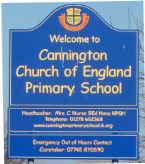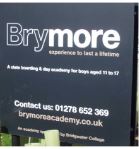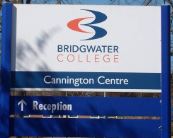 |
 |
 |
Education
| Cannington C of E Primary School | Brook Street | Tel: 01278 652368 Headteacher: Mrs Claire Nurse Secretary: Mrs Ann Boucher Email: [email protected] Website: www.canningtoncofeprimary.ik.org |
| Cannington Pre-School | Brook Street (on primary school site) | Contact: Emma Nurse Tel. No: 01278 652720 email: [email protected] |
| Brymore Academy | High Street | Tel: 01278 652369 Head teacher: Mr Thomas Email: [email protected] Website: www.brymoreacademy.co.uk |
| Bridgwater College | Bridgwater College, Bath Road, Bridgwater, Somerset TA6 4PZ |
Principal: Mike Robbins |
| Bridgwater College Cannington Centre | Rodway Hill Cannington, Bridgwater Somerset TA5 2LS |
Acting Head of Land-Based, Sports, & Services: Jason Gunningham Tel: 01278 455464 Info & guidance: 01278 441234 email: [email protected] website: www.bridgwater.ac.uk |
| Haygrove School | Durleigh Road, Bridgwater | Tel: 01278 455531 Headteacher: Mrs K M Canham email: [email protected] www.haygroveschool.co.uk/ |
An individual history of the schools in our village follows. For information about Cannington College please go to About Cannington and read the section about The Priory/Cannington Court
Cannington C of E Primary School
A parish school for all denominations was set up in 1732 in the Almshouses and the Master was paid £5 per annum. In 1764 Lord Clifford set up a Roman Catholic School, the Headteacher being paid the same as the head of the Parish School. In 1794 and 1801 the Misses Sarah and Mary Warren left money for a Schoolmistress to teach poor girls reading, knitting and plain needlework. The pay was £2.50 per annum.
The core of the present building in Brook Street was erected on land belonging to Lord Clifford in about 1836. This was the National School and no more children were taught in the Almshouses after 1840. The school houses 279 children and the endowment by that time was £3.12s.6d and this was supplemented by 2 or 3 pence per week paid by the children attending. Average attendance was fewer than 150. Early in the 20th century the school became a Public Elementary School and the value of the endowment had fallen to 13s.4d. In the 1930’s the Clifford Estate sold the land to the Church, which later set up the primary school.
During 1940, a London school was evacuated to Cannington with its own staff. This school was held in the Village Hall but as children returned to London and numbers fell, the remainder joined Cannington school but continued to use the Village Hall. The infants and seniors were housed in the main building and some juniors in the Village Hall Committee Room. The main hall was used for PE and country dancing.
At this time the school consisted of the hall, divided by a screen, on one side of which were the upper juniors and the seniors were taught on the other side. The kitchens and the lower juniors classrooms were across the entrance hall as were the infants’ classrooms and cloakrooms. The boys toilets were in the yard behind this and the girls’ yard with toilets was behind the juniors classroom with washbasins in an open sided shed. Coke burning stoves heated each room and there was no staffroom.
In 1948 the Village Hall was still being used as a classroom and a request by the managers for two Horsa huts was approved with the possibility of a staffroom. During the 1950’s more use was made by the village of the school facilities: band practice, WI, drama rehearsals, the Flower Show and Church Fete. In 1955 there were 4 male and 4 female members of staff and a clerical assistant was appointed. However, the following year saw the end of the all-age school and there was no deputy heads’ allowance as numbers fell below 200. Numbers soon rose again and by 1963 there was an urgent need for more teaching space as two infant classes were being taught in one of the Horsa huts and eventually two Pratten huts were erected and the PTA funded the new swimming pool.
Following the sudden death of the Headmaster Bill Pyke and the appointment of Walter Harris, the school underwent considerable remodelling including a new kitchen in the front of the main hall, an open plan infant’s area with cloakroom and toilets and a new library. During these works temporary classrooms were placed on the playground.
In 1984 Michael Bailey began 14 years of successful headship, being held in high regard by the community. A small copse of trees has since been planted in his memory. In 1998 Mrs Mary Culligan was appointed head, becoming the first ‘headmistress’ of the school. During this period of time the Horsa huts were demolished and a new teaching block was built and dedicated by the Bishop of Bath and Wells in September 1999. In 2002 Mrs Jan Hossent was appointed as the next Headteacher, serving the community until the summer of 2010. During this period the swimming pool was demolished and a new double Elliott hut was installed to become the base of our extended school provision and a new home for Cannington Pre-School.
Our current Headteacher, Mrs Claire Nurse, was appointed in September 2010. We currently have six classes and 180 pupils on roll. These classes are taught by 9 full time and part time teachers who are supported by a Deputy Headteacher, Special Educational Needs Coordinator, 10 learning support assistants, a full time administrator and finance officer, a cook and her assistant, 6 lunchtime supervisors, a caretaker and three cleaners. Our school is supported and challenged effectively by an effective governing body. The school continues to be supported by a very active Parent Teacher Association who is committed to providing the little extras that make school life so memorable.
Our school has seen several changes in recent years including the installation of Wi Fi and mobile IT resources, the creation of a new production kitchen feeding on average 100 pupils each day, the development of outdoor learning spaces for our younger pupils and our latest project to create a spiritual garden for our school community.
We are currently judged as ‘good’ by Ofsted and ‘outstanding’ in our last Statutory Inspection of Anglican Schools.
Brymore Academy
Situated at the top of the High Street is a complex which provides evidence of the long and varied history of Cannington – Brymore Academy. The main house and surrounding land have not been that well documented in the past but what has been researched provides a small insight into its history.
About one thousand years ago, in Saxon times, the land around Brymore was worked by a man named Edric. After 1066 William the Conqueror carved England up between his supporters and by the 12th Century the land was owned by a Norman family called de Coursey.
The name ‘Brymore’ came later but its origin is not clear. It may have come from a Geoffrey de Bramora who held the land in 1216, or it may be a corruption of ‘Broom Moor’ after the wild yellow flowered shrub.
By the end of the 13th Century Brymore belonged to the Pym family who held it until the death of Mary Pym in 1729. It was one of the Pyms – probably Phillip – who built the present porch, in the early 1400’s, while a stone built drain that runs from the main building to Padnoller Brook and a well outside the stable block may date from the same time.
The most notorious member of the Pym family was John Pym (1584-1643). He was a well-known figure during the Civil War, being Oliver Cromwell’s right hand man. He was the mastermind behind the Parliamentary Campaign and without him the Parliamentarians might well have submitted to Charles’s unbending attitude and agreed to compromise.
In 1936 a document was found in the attic at Brymore. Dated 1400 it allowed a certain Isabel, step-mother-in-law of one of the Pyms, a pension of five marks (£3.50) a year and a lodging called Hodkins Chamber which appears to have been a one-roomed house near the main residence – a sort of medieval granny annexe.
In 1729, Brymore passed from the Pyms to the Hales family and then, in 1836, to the Pleydell Bouveries. The Bouveries were great benefactors of the surrounding area. One of the stained glass windows in Cannington Church is a memorial to some of the family and no doubt Bouverie Road, off of the main Quantock Road, has some connections to the family. They added considerably to the house but early this century one of them is said to have over-indulged his passion for the theatre and possibly actresses. Stories have it that he was in the habit of chartering special trains from London to Bridgwater to bring an entire company of a musical comedy to Brymore for a weekend’s entertainment. Not surprisingly, the estate fell into decline.
In 1928 the house was sold to Gordon Cecil Hart and remained in his hands until 1936 when it was acquired by Louis Brugerie who in turn sold it to Richard Dorr Penoyee the following year (1937).
When World War II started, it was at first proposed that Parliament should move to Malvern College so the girls of the college were moved to Brymore. They only stayed one term and were replaced firstly, by Italian prisoners of war and then Germans. In 1943, the 535th Automatic Weapons Battalion of the US Army moved in. The officers slept in the main building and the other ranks in tents. The initials of at least one American are still carved in the lead flashing on the roof of School House and the gun emplacements can still be seen near the ponds and elsewhere. Their heavy vehicles were parked along the front drive and they so compacted the soil that it is still hard to grow trees between the drive and stream.
The south front of the building has not changed much and consists of five roughcast bays dating from the late 18th Century, probably built in two stages with three later ones added in the 19th Century to the east of the rubble and brick dressing. The porch dates from medieval times and from the main office can be seen the original stone staircase. The one-acre of walled garden dates from 1753 and is worked today by boys who have their own plots, along with fruit trees. The 18th Century Orangery although used for storage still portrays the elegance of such a building in its heyday. The large late 19th Century stable block now houses the school’s workshops.
On 26th June 1951, Somerset County Council purchased Brymore when it came up for sale at a total cost of £6,600. Following extensive repairs and alterations it opened as Secondary Technical School of Agriculture in September 1952. The school is unique and boasts its own farm, gardens and workshops which are second to none.
The aims of the school have changed little over the years: to give a sound general education to boys motivated by a strong interest in agriculture, horticulture, crafts and the countryside irrespective of their ultimate careers. Boys work and run the 100-acre school farm that includes a dairy herd, beef animals, sows, poultry and a flock of ewes with lambs. Crops are grown with the dairy herd in mind but as many other crops as is possible are grown on a smaller scale, including potatoes, which are supplied to the school kitchen. The commercial glasshouses, poly-tunnel and walled garden also supply fruit and vegetables for the school kitchen. The students pursue their horticultural interests through working on individual plots in their spare time. The extended workshop complex was opened in 1988. Formerly the stable block, it contains specialist areas for wood, metal, plastics and control technology as well as a foundry and a forge for budding blacksmiths. The workshops also contribute to the construction, maintenance and repair of equipment, furniture and machinery used elsewhere in the school.
As many students are boarders evening activities are very popular and cater for different tastes and interests and include badger watching, art, photography, fishing, Duke of Edinburgh’s Award Scheme, fitness, weight training, Young Farmers, blacksmithing, archery and swimming. With the agricultural backgrounds of many boys the school has strong ties with local societies and regularly provides working parties for the Royal Bath & West Show and South West Game Fair.
For information about Cannington College please go to About Cannington and read the section about The Priory/Cannington Court